Maniacal Machinations
For whatever reason, it seems like young teenage girls can rarely live a normal life. Whether it’s due to invaders from another dimension, invaders from space, or even other angsty teens, girls can’t just be girls. As such, the only way they are permitted to earn that simple freedom is to fight using some giant robot or another (or fight to the death in a parallel universe). Either way, there is usually a malevolent mechanized force at work, and only those with strictly X chromosomes can stop it. Read on for more mechanical mayhem.
Aquarion Evol
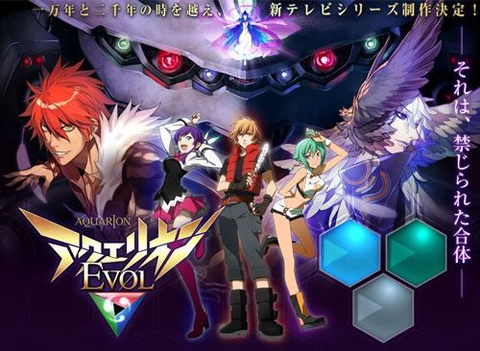
Fuck you, Jack.
Aquarion Evol takes place 12,000 years after the conclusion of the original Aquarion series. In that time, the story of Apollon and Sylvie has become a children’s story called “Skies Of Aquaria”. However, a new force threatens the Earth, as the Abductors from another dimension, Altea, come to harvest humans in order to maintain their increasingly unstable world. As such, the Aquaria Academy trains men and women to use Aquaria, but they are never allowed to merge. This is due to the administration’s installation of Guize stones, which block an “unholy union” between genders. The story follows an outsider named Amata and a female pilot named Mikono in their enrollment into DEAVA and their fight against the Abductors.
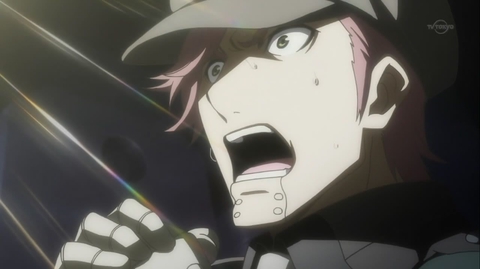
And against the prudish administration.
For years, it has been one of my many missions in life to make sure everyone knows that Aquarion is the worst anime ever. Mind you, I don’t take that word lightly, so on the rare occasions that I utter it, you’d best believe I mean EVER. So when I discovered that not only was there to be made a sequel, but that I would have to watch and review it, you can imagine my response.
That said, apparently 12,000 years is enough time to make the franchise slightly less appalling. The only reason the franchise even has a second series at all is likely due to a situation similar to that of M.D. Geist: the owner of the company had some role in the original, so it’s become his only claim to fame (i.e. infamy). As such, the studio must reluctantly create a sequel true to his vision. This means throwing obscene levels of money at the problem until it’s just barely passable by even today’s troll show standards. What does taking money from more deserving series get you? Surprisingly detailed animation pervades the series. Backgrounds are immersive, and architectural anachronisms are kept to a minimum, aside from the obnoxiously huge Aquaria Academy.
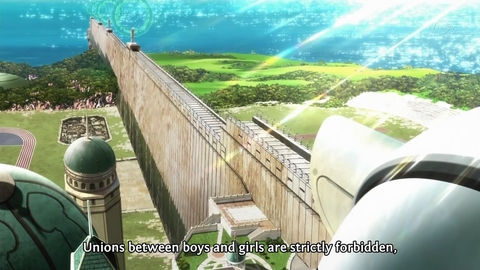
And their giant Prude Wall that extends off a cliff and 2 miles out to sea.
The soundtrack differs slightly from the original, with more instrumental work than before (if that’s even possible). Voice acting remains…silly, yet the actors do remain true to the script, so it’s hard to complain. But what is an Aquarion series without its gripping storyline (in before “Pleasant”)?
The forces of Earth once again have to face invaders from another dimension, but they are decidedly less derpy (i.e. human and not godlike figures). Also, the landscape is actually pleasant to look at, not just the apocalyptic landscape of the original. Actually, the landscapes of the two series have reversed, with the Earthlings living in an otherwise peaceful setting and the invaders in continuous danger. Such a role reversal seems to give the invaders considerably more depth of character, since they actually have to fight for their survival, as opposed to simply stepping on ants in another dimension. However, the last several millennia have allowed humanity to regress a bit, and although Earthlings possess the power of Aquaria, they have become prudish enough to install chastity rocks in their robots and even go so far as to segregate the two genders from fighting in the same battles (because the robots might start coming on to other robots…or…something). Even with all these extremely repressive measures, the original aspects of Aquarion seep through, and with them flood back the seething rage I felt. The classic Voltron-esque combination technique tries to cross over with Evangelion’s idea of “unity,” and the results are hilariously bad, though admittedly not as bad as the original. Still, Aquaria’s concept of “unity” remains far more bastardized than even Gainax dared to attempt, and the combination sequences are as physically painful as ever. The characters, on the other hand, are far more tolerable than before for no other reason than their younger high-school age group, since most modern anime viewers are just used to young characters being reduced to cheap fan-service at this point. Before, when the fighters were mostly adults (and genetically related), the “union” scenes were just too troubling to try thinking about. Despite the decency of the fighting scenes, even that is often tainted by Aquarion’s unforgettably derpy call signs, including stupid “fighting” moves. Even though the show has most of the silliness of the original, it is far more toned down, and that makes it at least less unbearable.
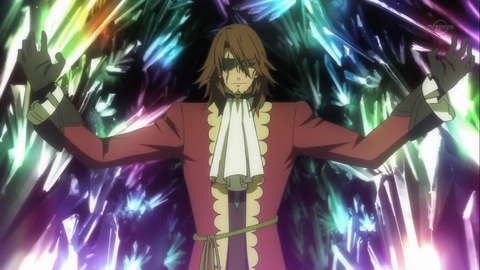
But there's still that fucking Magician!
So, does Aquarion Evol sink to even deeper depths than the center of the earth to claim the title of worst anime EVER? Surprisingly, this is one of the rare cases where the sequel is better than the original. However, that hardly makes it anywhere near decent. Just like the original, Evol is dragged through the sewage by the franchise’s trademark silliness and lack of direction. As such, it might not be the most awful television show in existence, but it’s certainly awful enough to be worthy of the DEEN’s List. This franchise should be shot into the Sun, lest the very idea of Aquarion once again rise to the level of human consciousness in another 12,000 years.
Rinne no Lagrange
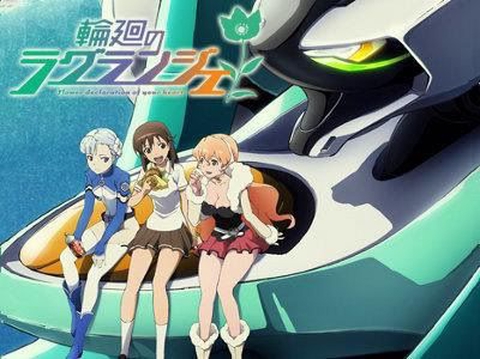
AKA Mecha Shoujo Madoka Robotica
Madoka Kyouno is the lone member of her school’s Jersey Club. Despite that, she is extremely energetic and amazing at whatever sport she does, which makes her very popular with every other club. So one evening, her older cousin Yoko returns home and shows some immediate concern for Madoka. The next day, a mysterious girl in a strange uniform appears at her school and asks to join Madoka’s club. She quickly accepts her new comrade, Lan, without any hesitation. Just as quickly, Lan asks Madoka to help her pilot a robot. So the next day, both get transported to a giant fortress a dozen miles offshore.
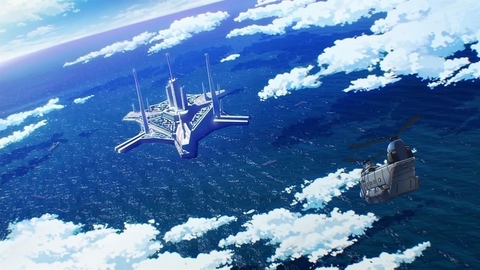
Which somehow qualifies as a ship.
There, Lan introduces Madoka to her robot, an Ovid named “Vox.” After touching the machine, she immediately has a vivid flashback of being deep underwater and interacting with Vox. Suddenly, another Ovid appears a mile out approaching the fortress. Lan then reveals that she is from space and her assignment is to protect Madoka and Vox. Since the Ovid is being remote operated and Lan hasn’t yet seen much of Madoka’s hometown of Kamogawa, she decides to pilot the craft. As Vox launches, Yoko manages to sneak aboard the fortress, and she seems thoroughly displeased that Madoka is piloting. The fortress commander tries ramming Vox into the enemy Ovid, but when that doesn’t work, Madoka wrestles over control of the Vox herself. The enemy pilot tries to quickly subdue her, but instead gets defeated in a showy display of martial arts.
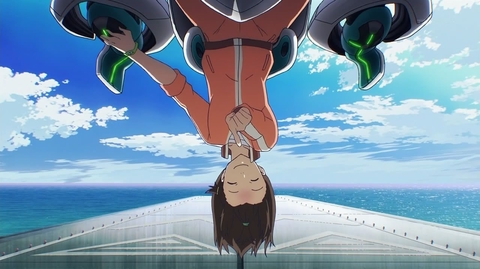
Perfecto!
It then becomes Madoka’s duty to pilot Vox and protect Kamogawa from space invaders. They are joined by a third girl, Muginami, who has a different goal than Lan. Meanwhile, they still don’t know their enemies’ true goal, or what “Rinne” might be.
Tatsu Sato has been very busy lately. When he’s not being booed off the stage for having directed Mouretsu Space Pirates, he’s being praised for directing Rinne no Lagrange. Whereas Mouretsu Space Pirates was being hyped as one of the next great pirate anime, Lagrange was already being criticized as yet another in the miles-long line of adolescent mecha series. However, Mouretsu Pirates has proven as consistent flop, and Lagrange has become a rare gem in a season of grossly misappropriated resources. So then, where has Lagrange done right and what still needs work?
First of all, the story sticks to the script: the girl is coerced into piloting a mecha against invaders from beyond the moon (who attack individually in their own menacing robots), a shady organization that runs the whole show, and multi-faceted characters. While that might seem like setting the series up for predictable failure, it actually gives the show some guidelines to work with. As grizzled anime viewers will tell you, it’s rarely ever about the premise but rather the execution. So if the storyline has little wiggle room, then the focus has to shift to the world and the characters, and Sato doesn’t disappoint. The Earth is caught in the middle of a large war between Lagrite and Demetria. Conveniently enough, both sides are humanoid, and both sides also have extremely polar opposite viewpoints. As such, everyone has their own agenda, and Sato goes to work immediately humanizing the extraterrestrials. The Demetrians aren’t just marauding jerks for which Earth is just another rock. Each of them has their own background and history, and they’re all emotionally invested in their endeavor. The Lagrites, in contrast, are more emotionally reserved, as seen by the emotionally complex Lan and her cheerfully manipulative servant Moid. In the meantime, the Earth fleet commander is equally wary of both sides and what it means to choose one group over the other. However, all this is done slowly and simultaneously, like a hazy image gradually coming into focus. This naturally incremental form of world-building keeps the viewers’ attention without being overt and obtrusive. It’s the way world-building should be done.
The characters of Lagrange also contribute greatly to the overall feel of the series. Madoka plays an exceptional, strong-willed female lead who is determined to help anyone in need with all of her power. However, Sato’s signature is still left on her: Madoka acts pretty derpy, although in ways which are far more varied (and therefore more bearable) than Marika. The odd part is that instead of being downright annoying like in Mouretsu Pirates, her silliness feels well-timed, like a defense mechanism meant to diffuse an otherwise overly tense situation, or to balance out her superior physical skills. Madoka’s character is balanced out by a still stronger female role in Yoko, although her personality is definitely abrasive, even to Madoka. Then there’s Lan, who has an early personality that reminds me a lot of Eureka from Eureka 7 (and this is just the first of many comparisons). That is, Lan is serious, straightforward, and visibly fearful underneath her calm exterior. However, she does have eccentricities of her own, including her natural acceptance of Madoka’s derpiness and her occasional dog imitations, including a raised paw and a sobering “arf!” Along with the slow and steady developments of Moid and the Demetrians, as well as the trio-rounding Muginami, the characters all get enough time and interactions to truly develop, which remains rare these days, and all but non-existent in the world of Mouretsu Pirates.
The difficulty arises when the viewer tries to gauge the tension of the series at first. There’s obviously a good amount of information that Lan is keeping from Madoka, but Madoka does seem to quickly win her over. Aside from that, there are relatively few moments of consequence so far. The narrative is constantly affected by very negative undertones that can steer the show in some really dark directions at any time. Yet this never actually happens, with the atmosphere staying lighthearted and even naive from the beginning to the end. The setting has events and secrets of epic scale, but the story is mostly uneventful episodes about high school slice-of-life and friendship drama with only minor conflicts. Knowing that Lagrange has a second season leads me to believe that much of this is simply stalling in order to draw out the story toward a more serious and consequential direction. This is a glaring problem that Sato has yet to properly address in Mouretsu Pirates as well, so it is concerning that much of season 1 has become padding. Fortunately, when the plot finally shifts into gear and the stakes get higher, the emotional contrast is indeed palpable.
That aside, Lagrange has does have a fair amount of fan service, up 100% from Mouretsu Pirates (which is to say, up from 0%). But as is the nature of fan service, it feels awkward, forced, and unnecessary. While the characters don’t have to contort themselves for the viewer, there’s always at least 1 too many back shots every 5 minutes, and it’s a viewpoint that is always shameless and never discrete. The only seamless fan service comes from the use of plug suits and Lan’s uniform, but let’s face it, that’s never enough for the mecha genre.
The animation is often mixed. While the foregrounds are detailed and the water and hair physics are extremely accurate, the background artwork is downright awful. It would make some sense if the background was blurred with respect to the foreground, but here it just becomes a clashing mess. If nothing else, it forces the viewer to keep their eyes locked on the action, since the alternative is rage-inducing. The OP is very catchy, with highly detailed animations better suited for high-level amv’s
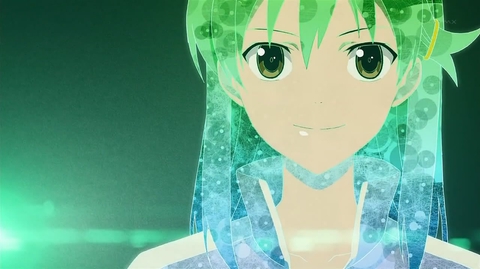
or a Stein's Gate OP.
The character designs also remain consistently good with minimal signs of moe, but the NPC’s often lack consistent features or even consistent anatomy. However, this is forgiven due to Sato’s bold decision to include the only plus-sized woman in all of modern anime as a regular in the war room.
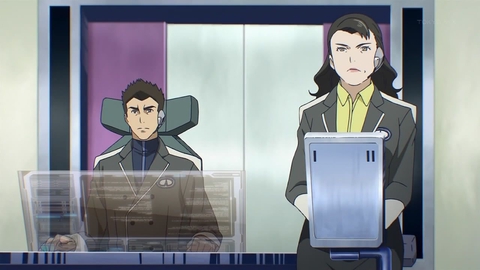
Which explains why she never gets out to exercise.
Another standout point is the emphasis on light color gradients, especially green, blue, and pink, which (again) remind me of Eureka 7. The colors blend into one another seamlessly, and nothing feels harsh on the eyes, except the scenes that take place in space. That said, Sato takes advantage of these light gradients to craft his vision of Kamogawa: a beautifully open, scenic beachside city built along a vast expanse of visually stunning ocean. This makes aerial fights all the more surreal, especially when the fights head underwater.
There are also obvious inspirational cues taken from Eureka 7, though the Ovids themselves have been designed by Nissan. The Ovids are reminiscent of the LFOs’ designs in Eureka 7, due to the curves and coloring of the main body, their ability to transform from a vehicle form to a more humanoid form, and the green particle-like light that flows behind them when surfing/flying. Action scenes, while interesting, start out low in their stakes, but then gradually rise from there. In the meantime, the battles remain entertaining, though rarely ever intense enough for emotional investment.
The music provides the finishing touches that really bring Lagrange into its own. The OP music is great, exuding a refreshing beat that hasn’t been heard in mecha since Code Geass or even Macross. The background music is good, often a mix of keyboard or orchestral instruments. The music also becomes invasive during moments of beholding, such as when Lan is first introduced at the school. The music bears the signature of Production I.G., which harkens back to the memorable soundtracks of Eden of the East and Ghost in the Shell. The latter evokes the viewer’s desire for a great action sequence, and it is often the harbinger of an Ovid battle. Then, just as suddenly as it enters the viewer’s consciousness, the music fades into the background and lets the characters interact uninterrupted.
On a mecha scale of 1 – 10 (1 being Sky Girls and 10 being Evangelion), Rinne no Lagrange ranks at about 7. Although the premise is hardly new, this mecha series has a real character-driven momentum, setting and direction that becomes increasingly difficult to ignore. It can be emotionally complex and serious, but frequent bouts of comic relief and character eccentricities help to keep the series light until the overall mood changes in season 2. Rinne no Lagrange proves to be lovely (lovely).
Black Rock Shooter 7 – 8

BRS: To Your Other Self
Episode 7 opens with Mato once again reminiscing about her favorite of all stories. However, she questions why she is so attached to the Little Bird of Many Colors, despite its inevitable color-based fate. Saya awakes and curses her inability to interact with and save her counterpart, Black Gold Saw. In desperation, Yuu decides to enter the Other World herself to break out Mato, noting Mato’s unique lack of negative emotions.
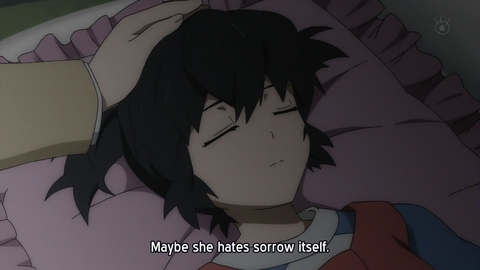
As opposed to those who tolerate and/or love sorrow.
Somehow, Mato is just as crazy as everyone else in this series, since she flat-out denies the sorrow of everyone else. So Black Rock Shooter complies the only way possible: by killing everyone’s counterpart and relieving their grief. Yuu gives Saya a brief farewell, and hurries off to the Other World.
As the battle between Insane Black Rock Shooter and the 5th being rages on, Yuu finally awakens Mato, who is still trapped inside Insane Black Rock Shooter. Apparently, the only way out is for Mato to reject her counterpart’s behavior. Mato then has a colorful hallucination, and the animation starts to interview Mato’s various family members about just who she is. Her characteristic good cheer stems from her never wanting to dwell on her or anyone else’s problems, but that has only transferring her issues onto Black Rock Shooter. Of course, endlessly doing this will inevitably lead to a systemic breakdown, and Mato realizes that is why she has always been attached to the Little Bird of Many Colors. Yuu tries to keep Mato from accepting this revelation, but suddenly the 5th being intervenes and finally speaks. It is at last revealed that Yuu Koutari is the 5th being, and her counterpart, Strength, has been Mato’s actual friend.
While Saya tracks down Strength at the riverbank, Yomi is sitting by herself at school unable to remember what horribly painful thing she forgot, and she feels that she’s better off for it. However, the teacher pops in to inquire if anyone knows why Mato has been missing for less than 24 hours. This causes Yomi to remember the source of her pain, and when the police show up at school, somehow Kagari also remember the source of her pain. So while Yuu continues to pile drive Insane Black Rock Shooter, Strength explains the purpose of the Other World to Mato. Rather, the Other World was created as a result of the pain and suffering of adolescent girls in the Real World, and the emotionless counterparts play out those internal conflicts in their stead.
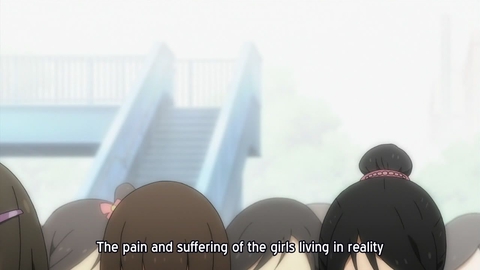
Boys have a similar coping mechanism called “Manning the Fuck Up.”
Then somehow the timeless Black Rock Shooter arrived to kill things, as is her way. Although Strength fell off a cliff and was about to die, she heard Yuu’s voice telling her not to die, so she somehow didn’t. Afterwards, Strength also began learning emotions. Since Yuu’s suffering is so exceptionally high in comparison to the other girls, Strength knew that Yuu would fall apart without her, so she became willing to do anything to protect Yuu. However, Yuu wasn’t seeking happiness but simplicity, and since the Other World is terribly straightforward, she proposes that her and Strength switch places. Strength agrees and is then able to experience everything reality has to offer, thus leading to her abnormally cheerful demeanor. Saya apologizes to the unconscious Strength for her having to shoulder all of their problems, hoping that Strength can protect the Other World in ways that she could not, since that place is Yuu’s only shelter from reality.
The episode closes with Yomi finding her disturbing painting of Mato. She touches it, and begins to remember everything about her friend. She runs to the roof screaming that she doesn’t want to remember. She then tears up thinking about how Mato had tried to be close with her (in some superficial way) and runs out of the school to find her, wondering why she ever tried to forget her in the first place. Suddenly, in the Pit of Fallen Counterparts, Dead Master shows signs of life.
The final episode opens with Yuu continuing to pummel Insane Black Rock Shooter and Mato having to suffer all of the damage. However, Strength will not allow her friend to be killed by Yuu, so she transports herself back to the Other World and plunges into the giant pit that connects to Strength’s realm. During her fall, Strength’s form begins to crack, which causes Yuu to lose all of her powers. Insane Black Rock Shooter seizes this opportunity to try beheading Yuu, but Mato has had enough and forces her counterpart to stop. In a flash of light, both Mato and her counterpart are transported at last to the realm of Black Rock Shooter.

Well, except for all those overhead lights.
Upon inspecting this realm, filled with checkerboard floors and black stalactites and stalagmites, Mato hears a voice. Insane Black Rock Shooter can now freely speak to her counterpart, who has herself assumed her true form.
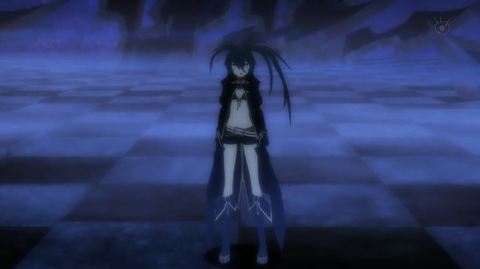
Kuro(i) Rock Shooter!
Meanwhile, a crumbling Strength walks over to the now powerless Yuu, who begins profusely complaining about the lonely and desolate reality that she’ll have to return to if Strength perishes. Strength counters by telling her how Mato fought to protect both of them. With that, Strength proceeds to carry Yuu to Black Rock Shooter’s realm.
Mato starts a big speech about wanting to experience pain herself without having to rely on Black Rock Shooter or anyone else, in order to spare them from sharing her pain. However, this is construed as Mato outright rejecting her counterpart, which earns Mato a swift pummeling. While lying there as a bloody pulp, Mato remembers the end of her story, recalling how the Bird of Many Colors died. She then realizes that although the bird died, it remembered all of its experiences until death. Since bravely accepting all experiences is the entire antithesis of this series, this revelation rejuvenates Mato, who is now ready to fight an all-too-eager Insane Black Rock Shooter.
In the Real World, Kagari, Kohata, and Yomi start to remember their previous bad experiences, and the tears start flowing. Yomi states that even though it has been so difficult for her to make friends, she wants more than anything to be friends with Mato, and to share one another’s pain. As Insane Black Rock Shooter begins to overpower her counterpart, 5 separate lights appear above Black Rock Shooter’s realm. By remembering their previous pain, the girls were able to inadvertently revive their counterparts, who lend their multi-colored power to Mato. She then unleashes her most preposterously large attack and defeats Insane Black Rock Shooter in a single rainbow-laden shot.
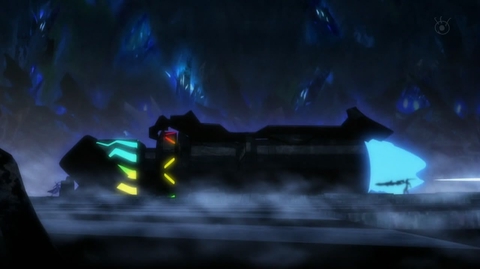
Skittles: Taste the Pain-bow!
However, the blast also destroys Black Rock Shooter’s realm and shatters the Fourth Wall, destroying all other realms in the Other World and leaving only the desolate gray landscape. Mato awakens amongst the monochrome next to a brittle Strength. Strength has a tender “death” scene with Yuu, telling her that the emotionless counterparts fight out of pure instinct because they intrinsically love their human counterparts. Although Yuu constantly protests that reality is far too cruel and lonely for her to bear by herself, Strength reminds her that the entire cast is there and ready to befriend her. However, the last farewell she saves for her best friend Mato. After crumbling into technicolor dust, Strength’s remains color the sky. With that, Black Rock Shooter vanishes off a distant cliff and Mato and Yuu are separately transported back to reality. There, Yuu awakens to a tearful Saya, who embraces her old friend.
While Mato wanders around the streets that night staring up at the stars, Yomi finally finds her. Mato runs up and hugs Yomi, apologizing for having ever caused her friend pain.
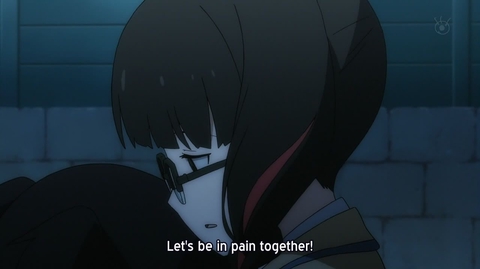
Well now that everyone in the audience shares that sentiment…
The story concludes with various short scenes, including Mato, Yomi, and Kagari walking to school, Kohata and her boyfriend walking to class, everyone getting introduced to Yuu (who is conveniently also in the same class), Saya slinging mud, and everyone holding up their own personalized bracelets, set against one final color-based soliloquy by Mato.
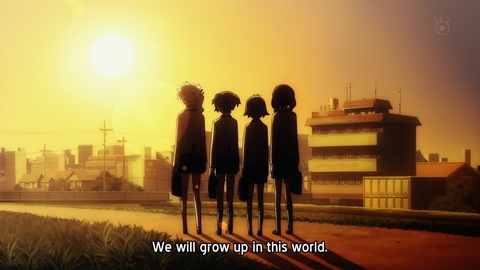
And then they formed a Light Music Club.
After the final credits roll, Strength is revived in the Other World, and Black Rock Shooter is there, ready and willing to fight on, bearing and sharing her counterpart’s hardship.
Black Rock Shooter began its existence as a simple character illustration. Then, someone took notice and created a Vocaloid song with an accompanying music video. More people took notice, and an OVA was created. From there, merchandising took root. So finally after it became popular enough, Black Rock Shooter was given an 8-episode anime series on the coveted Noitamina slot. Yet through it all, the only constants are the character designs, CG artwork, and the eternally nebulous reasons for why Black Rock Shooter even exists.
Since Black Rock Shooter literally evolved out of nothing, there’s no solid background or story to base her actions off of. The illustration inspired the song, the song inspired the music video, the music video inspired the OVA, and the OVA inspired the series. The problem is that making up a story as you go along is rarely ever as satisfying as if you have a refined base to work from. As such, the story goes in many different directions, each more displeasing than the last. When there are only 8 episodes to tell the grand tale of the Black Rock Shooter, perhaps a multiple arc format isn’t the best way to go about it. However, the most meaningful arcs are indeed the longest, and they relate directly to Mato. Namely, the main arc involving Yomi is the arc with the most character development, and understandably so, since Yomi (the brooding loner) has been incorporated ever since the OVA. That said, the fight between Black Rock Shooter and Dead Master is where most of the creative talent has been devoted, with exciting visuals and interesting fighting.
The disappointment starts when the story tries to move past this central conflict. In the series, Mato has a best friend in Yuu, whom she does everything with. While that gives Yomi some good fodder for further character development, almost everyone suffers from a lack of character development. Kagari’s complex and warped relationship with Yomi feels far more interesting than those of Kohata or Saya. However, even Kagari’s character is not completely thought out, as though a writer had a couple ideas on how to craft her character but then stopped half way. Kohata is arguably the worst victim of this problem, since she is reduced to being not a plot device but the result of a plot device. When Kohata fell to the floor in agony and forgot everything about her crush, I didn’t care about her, I cared about why that happened. There is something intrinsically wrong about writing in a character for the sole purpose of illustrating some abstract misfortune.
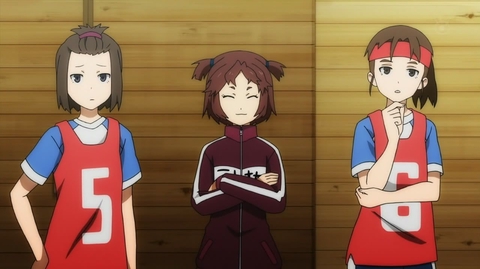
Then again, she always goes around wearing a red shirt.
Then there’s Saya and Yuu. For now, let us set aside the obvious continuity problems that arise when discussing how Mato (at roughly age 4) is able to almost kill the counterpart of a high school girl, or why Strength befriended the human whose counterpart nearly killed her, or why Strength’s developmental form has matched that of Mato (starting from age 4), how Saya has managed to stay in contact with Strength this whole time, or why Yuu ends up in the same class as Mato and the rest in middle school. No, let us instead talk about why Saya acts as she does. While the dynamic between her younger self and Yuu is very interesting, their overall back story feels much too rushed. If anything, the audience identifies more with Yuu than with Saya, because Yuu (or rather Strength) has been living an existence that directly contradicts the events that have transpired. Saya, on the other hand, is still as lazy, outwardly happy and overtly emotional as she’s ever been, but her thought process has become warped along the way. Theoretically, she became a student counselor because she wanted to prevent other people from suffering the way that Yuu has. However, instead of protecting girls from pain or teaching them how to properly endure it, she forces them into a vulnerable state, exploits those vulnerabilities, and then wants to outright kill the source of those stresses (namely, Mato). That’s the exact opposite of what she wanted to do for Yuu, and it’s the exact opposite of what she has been trained to do. Schools generally don’t let psychopaths run their health and human services department (unless you live in Silent Hill or Hinamizawa). One could argue that Saya wants to pursue the “tough love” approach, but a perfect example of that failure is Yomi. Saya put a lot of effort into awakening Dead Master, and Yomi turned depressive and bi-polar as a result. It’s doubtful that she would react well to reports of Mato’s death.
As for Yuu, her character is the most interesting one in the show, second only to Yomi. Despite her miserable situation, Yuu remains oddly stoic and calm. Of course, one could explain this away as her dumping literally everything onto Strength, but then how did Yuu even become aware of Strength. If Yuu really was under such stress, then why did Strength never “awaken?” As for the actual idea of swapping worlds, this turned out to be the best possible solution for Yuu. With her parents dead and her home gone, Yuu would have nowhere to return to, so the Other World provided literal and figurative shelter. With Strength in the Real World, she never needed shelter (what with apparently being incorporeal), she wouldn’t have to deal with the bullying that Yuu went through in high school, and she could experience the world positively while growing up with a friend. And make no mistake, the story would have likely taken a far darker turn if Strength started out in the same situation that Yuu did. It’s easy to bash Yuu for being such a whiner near the end of the series, but considering what she left behind after having come to the Other World, it’s equally easy to understand her extreme unwillingness to go back. Though it is surprising how Yuu has acted so perfectly stoic in The Other World, but then she becomes more insane than anyone else whilst fighting in her own realm. However, it would have been more satisfying to see a slide into madness, rather than happy Strength, or stoic Yuu, then suddenly psycho Yuu.
Finally, there is the cheerful main character Mato, whose background is arguably the most frustrating. Her back story was never really fleshed out in the OVA, so the first question on everyone’s mind was “who is the girl behind the Black Rock Shooter?” Well, it turns out she’s an airhead. “Ok, but surely she’s had some deep dark event in her past, right?” Nope, by all accounts, she’s had a pretty comfortable life. “Perhaps she’s a strong character because she’s so attuned to the people around her.” Actually, she remains oblivious to everyone around her unless an event happens right in front of her face. “Well then why does she have a counterpart as awesome as Black Rock Shooter!?” Irony.
Indeed, there’s no real evidence to support why someone as unassuming as Mato Kuroi wields such an overpowered counterpart as Black Rock Shooter, except that somewhere along the line she just decided that everyone either can or should have as tepid a life as she has. That means no conflict, no pain, no angst, and no argument. And it’s far deeper than simple naïveté. She hasn’t experienced events such as conflict and rejection, likely because she either avoids them or denies them. She actively thinks about the best in people instead of properly identifying that some people are just mean or hateful or fundamentally clash with her beliefs. This provides a glaring disconnect between the first battle in the series and the subsequent episodes. Mato denounces Yomi and her mother’s enabling of Kagari and tells Yomi to push Kagari towards personal independence and growth. Black Rock Shooter doesn’t recognize the concept of personal growth, but she does recognize how to put an end to others’ pain. Unfortunately, that means killing everyone’s counterparts, but that only temporarily solves a single stressful moment in a young girl’s life. What happens when they have to deal with actual problems? In this regard, Black Rock Shooter is more of a representation of Mato’s subconscious issues than anything else. She wants people to change and grow, but her little speeches are almost never enough to convince people. So what can she do then? And really, the problem is that she feels compelled to take the issue into her own hands. This was pointed out by the upperclassmen on the basketball team and the interviewees near the end of the series. Mato’s not a team player. Mato acts very guarded. Mato seems unnaturally cheerful. Since Black Rock Shooter can only understand outside stress as an enemy attack, it becomes unclear whether Black Rock Shooter rushed to find Dead Master in order to save her from “awakening” or to kill her before she could awaken. Likewise, it feels as though Black Rock Shooter awakened not because she had killed Dead Master, but because Mato freaked out due to Black Rock Shooter taking extreme action that was not expressly permitted by Mato.
While these subtle contradictions add a little depth to Mato’s character, she remains far too weak to justify her central role, and the way in which her character is conveyed does her no favors. The writers even have to resort to an interview segment just to spell out Mato’s weak character flaws. These characters combined carry less than 40 seconds of lines and yet somehow the viewer is supposed to take what they say with as much gravitas as Yomi or Yuu. There is an obvious directing problem if 8 episodes is insufficient time to properly display those 3 simple traits. Show her hogging the basketball at least.
There are also multiple problems with the concept of the Other World. First off, the Other World is strictly for females, as though to indicate that males could never understand the subtleties involved with emotionless warriors wandering from battle to battle in an endless wasteland. Furthermore, the show tries to make the point that the Other World is created and sustained by the hardship of young girls in reality. So then why does Saya still possess a counterpart? Or rather, how and why do more mature women lose their counterparts? I have a feeling that this has to do with the idea of personal realms vs open space at the end of episode 8, since it seems that the counterparts had to willingly relinquish their realms in order to unite under a single goal. In that sense, perhaps the Other World exists solely to help women cope with their issues until they reach maturity, in which case counterparts just come and go. Still, that’s quite a stretch for the viewer to have to make based on very minimal data. It just feels as though the idea of the Other World was never fully explained, and it’s this ineffective approach to explain away the previous idea of that place as an extended metaphor that makes the whole concept all the more frustrating. If an abstract idea cannot be suitably explained to the audience, then perhaps it’s best that the viewer’s precious time not be wasted by sub-par attempts.
Mind you, Black Rock Shooter isn’t all bad. After all, the main attraction throughout the entire franchise has been the action scenes, and they rarely disappoint. The CG work of the Other World makes the fights all the more surreal. The colors are vibrant, the realms are highly personalized and distinctly haunting. The problem is that the action that takes place during the fights feels so pointless. The counterparts bleed, get beat up, and eventually even sustain damage, but you wouldn’t notice it after 5 solid minutes of gatling-gun fire. Sure there’s superfluous damage, but there’s no actual suffering. Then the audience finally gets to see the fight between Insane Black Rock Shooter and Yuu, and I can’t help but laugh throughout the fight. There are at least 3 separate moments of pure gif material per episode for 7 and 8, and it quickly feels like I’m watching a Looney Toons fight sequence. Of course, even after all that, Insane Black Rock Shooter is ready to rock when she has to fight Mato, and she beats Mato to an inch of her life in about 5 seconds. That stands as a credit to just how powerful the counterparts are, but Mato is instantly restored just a moment after her little revelation about the Bird of Many Colors.
This brings us to the most poignant problem with this series: there is nothing of consequence. All of the conflict in the series builds up with the awakening and death of counterparts. So the closest the story ever gets to permanent change is when the counterparts die, and the worst that happens is targeted amnesia. However, even this is nullified by the revival loophole, where all they have to do is remember what happened. This ruins whatever drama the series was trying to create, because it’s a pretty easy loophole to exploit, especially if you have friends to remind you what you just forgot. The Little Bird of Many Colors just knocks the dust off and gets back up in the air, the criminally inept Saya still keeps her job and even becomes friends with Mato and the gang, and Black Rock Shooter keeps on needlessly fighting.
The series was already starting on shaky ground after the OVA, but this ending negates everything that had previously transpired so effortlessly that the entire story becomes almost pointless. Even hardcore fans of the franchise have difficulty accepting this series because it flies in the face of a lot of what they’ve come to expect from high-profile series. It becomes even more difficult to accept due to the absolute suspension of logic that has to take place. This show is not about normal reactions, but rather about creating drama from tiny little issues so the other girls could fight amazing battles. It’s troubling that these girls couldn’t handle such small problems without totally losing their marbles. In the grand scheme of things, those small events would not greatly affect their futures. Unfortunately, the series just doesn’t translate well from the abstract concepts that it arose from, and the story, animation, and myriad of plot holes reflect that. Sorry folks, but Black Rock Shooter the series blows chunks.
Final Rating: 6.5/10
Come back next time, when I review shows so terrible, I’ll be howling in the shadows.